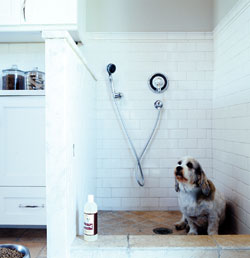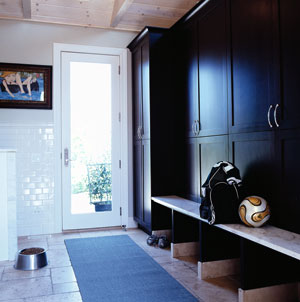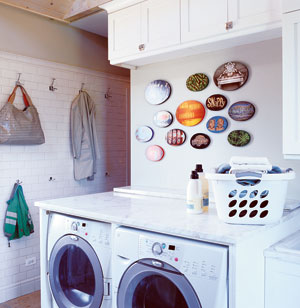 |
|
Lucky dog Luthringshausen designed a dog shower for the mudroom that has several uses. The basin is made from smaller squares of the same highly durable tumbled limestone floor tiles used in the rest of the room. The shower has proven to be convenient for hosing off muddy boots and sweaty soccer players. |
Used to be, if you had the space for a mudroom, it was a small, nothing-special place. Maybe it held a coat closet, the washer and dryer, and—if you were lucky—a bench to sit on while dealing with boots. But as houses have swelled in size and become more informally designed, mudrooms have gained status, providing a crucial transition area between indoors and out. Given their bumped-up size, not to mention the increasing use of high-end finishes and special touches like drinking fountains, “mudroom” has become something of a misnomer, says Kiki Luthringshausen, owner of the Lincolnshire-based interior design firm K-Haus (k-haus.com). “Out in the suburbs we’re doing a lot of what we’re calling ‘locker rooms.’”
Luthringshausen’s own mudroom typifies the trend. When she was pregnant with her fourth child, she and her husband, Vincent Florack, had to decide whether to move to a bigger house or stay and expand their Kildeer home. Ultimately they chose renovation, and included a super-sized mudroom to accommodate their growing family.
 |
 |
|
Out of sight Essential to keeping the family organized is a run of custom cherrywood lockers. “I had my heart set on all white,” Luthrings- hausen says. “But any painted cabinet tends to chip. Knowing my crew, we did the cabinets in dark wood instead.” Arranged in order of the children’s ages, ranging from three to 13, each locker is wired with electricity for recharging cell phones and handheld electronics on an eye-level shelf. Baskets on top shelves hold out-of-season gear; another, within easy reach, holds currently used items. |
Clothes encounters The family’s white, marble-trimmed kitchen is at the other end of the wall with the coat hooks, so the mudroom needed to flow visually into the adjoining space. White subway tile on the walls not only maintains the aesthetic of the kitchen but also provides a waterproof surface for soggy coats and beach towels. The front-loading washer and dryer has a Calcutta marble laundry-folding shelf above it. The painted cabinets hold household goods and laundry supplies. |
Photography: KATE ROTH


